The digital epoch overwhelms modern humans with an endless stream of information. Among this vast flow, blogging stands out as one of the most popular sources of information, with around 7 million blog posts published per day in approximately 600 million blogs available in the world.
While this number is exciting for readers (isn’t it great to always have something to read?), it can be scary for those on the other side of the screen tasked with coming up with fresh blog topic ideas to write about.
While you may think it’s tricky to compete with an abundance of blogs when your target audience’s attention is limited, we gently remind you that it’s quality that matters, not quantity.
The best competitive advantage in the era of much information is quality information. No matter the niche or subject or how many other blogs are out there covering similar topics, if you can produce unique and valuable content, you will attract an audience.
For those seeking inspiration and new ideas, here is a list of 100+ outside-the-box blog ideas to write about in 2024.
Put your heavy armor of creativity on, and let’s dive in!
Why Creative Blog Ideas Matter for SEO in 2024
Well, friends, what’s an SEO of 2024?
It’s a digital animal with a constantly changing diet and appetite for quality content.
The SEO beast loves to chew on original, relevant, and up-to-date information.
Gone are the days when going after the same keywords with the same content as competitors could guarantee a spot on the first page of search results.
2024’s SEO, where blogging still plays a crucial role, is all about uniqueness, topic relevance, and well-organized user experience.
High-quality, long-form content of over 3,000 words gets 3x more traffic and 3.5x more backlinks. This preference toward longer, in-depth blog content requires you to close the page of average-length (up to 1,200 words) blog ideas that usually limit you from digging deep into the topic.
Only by knowing your audience inside out and crafting unique, well-researched content can you achieve search engine love that leads to higher rankings, increased traffic, and more conversions.
So, the new equation is good blog content ideas = highly relevant topics to your audience and presenting a fresh perspective on the subject.

Creative Blog Posts by Theme
While your brain now buzzes with ideas about where to start, a small kick in the right direction will come in handy.
Below, we share a treasure-land of creative blog ideas by themes.
- Firstly, the themes below are evergreen, meaning you can use them for a long time without running out of things to write about. Universal themes are your safe bet if you want to win organic traffic but don’t have a particular passion or niche.
- Secondly, the below ideas are more than just rough topic suggestions to write once and forget. You can use this initial skeleton to create blog posts on the same topic, keeping your audience engaged and eager for more.
Let’s see what we’ve in stock for you!
Arts and Culture
“Art washes away from the soul the dust of everyday life,” said Pablo Picasso. That’s why humans, no matter how finance-oriented, political, or scientific, have an innate need to interact with art. So, relying on blog content ideas that touch upon arts and culture can never go wrong. If you can come up with great content in this niche, you can become a big audience’s “unwind after hard workday” destination.
Here are some blog ideas to start with.
- A Review of the Latest Art Exhibitions in Major Cities
- Street Art in Different Corners of the World and What It Reflects About Society
- Analysis of Award-Winning Films and Their Social Commentary
- From Shakespeare to Modern Times: Evolution of Theater and Its Reflection on Society
- The Fascinating History and Evolution of Graffiti Culture
- Uncovering the Secrets Behind Iconic Masterpieces: From Mona Lisa to Star
- Folklore Legends from Around the World and Their Impact on Culture
- How Art Therapy is Used for Mental Health Treatment
- The Intersection of Technology and Art: From Virtual Reality to AI-Generated Art Pieces
- The Emotional Impact of Music: Exploring the Connection Between Sound and Our Minds
Science and Nature
The marvels of science and nature are endless. There is always more to unveil, discover, and learn about Mother Earth and the universe that captivates people’s minds. In the fast-paced 21st century, where scientists make groundbreaking discoveries almost daily, keeping up with science and nature blogging is not only exciting but also challenging. That may be a mind-squashing puzzle, but it’s also an opportunity to inspire and educate your readers.
So, here are some creative blog ideas in this genre.
- The Latest Space Discoveries by NASA
- How Climate Change is Affecting Different Ecosystems on Earth
- Exploring Unknown Species: From Deep-Sea Creatures to Insect Worlds
- The Science Behind Popular Myths: From Bigfoot to Bermuda Triangle
- Fascinating Facts About the Human Brain That Will Blow Your Mind
- Breaking Down Complex Scientific Concepts for the Everyday Reader (quantum physics, anyone?)
- Natural Disasters: Causes and How We Can Prepare for Them
- De-extinction: Bringing Back Endangered Species Through Cloning Technology
- Strange Phenomena in Nature That Scientists Are Still Trying to Explain
- Mars Colonization: Possibilities and Challenges in the Near Future
Business and Entrepreneurship
How many of us have dreamed of being our own bosses? Statistics show around 42% of Americans consider entrepreneurship as a career option. And where do all those people try to find inspiration, guidance and problem-solving? In the real stories, tips, and advice from fellow entrepreneurs. If you have entrepreneurial experience or just a big interest in the subject, you can use your blog to connect with this large audience constantly craving knowledge on how to make it in the entrepreneurship world.
Take a look at some business blog ideas that will get those creative juices flowing.
- Start-Up Success Stories: Lessons Learned From Entrepreneurs Who Made It
- Navigating the World of Venture Capitalists and Angel Investors for Funding
- The “Side-Hustle” Phenomenon: Turning a Hobby into a Profitable Business
- Lessons in Failure: Why Some Start-Ups Don’t Survive and How to Avoid It
- The Art of Networking: How to Build Valuable Connections in the Business World
- Creative Ways to Generate Passive Income Streams as an Entrepreneur
- The Importance of a Solid Business Plan and How to Create One
- Women in Entrepreneurship: Breaking Barriers and Challenges They Face
- Taking Care of Mental Health as an Entrepreneur: Addressing Burnout and Stress Management Techniques
- Innovation and Disruption: How to Stay Ahead of the Game in an Ever-Changing Business Landscape
Personal Development
Stats say that more than 40% of adults use some type of self-help materials related to personal development. The fear of stagnation and not reaching one’s full potential is a common concern, and that’s where the personal development niche comes in. Whether it’s tips for better time management, career advice, or ways to improve relationships, people are always looking for guidance and inspiration on becoming the best version of themselves.
Here are some blog topic ideas for a personal development blog.
- The Power of Positive Thinking: How to Cultivate a More Optimistic Mind
- Goal Setting and Success: Strategies for Achieving Personal and Professional Goals
- Overcoming Self-Doubt and Building Confidence
- Mindfulness in Everyday Life: Techniques for Living in the Present Moment
- Building Healthy Habits: Nutrition, Exercise, and Mental Well-Being
- Finding Balance in a Busy World: Ways to Manage Stress and Prioritize What Matters
- Breaking Bad Habits: Strategies for Overcoming Addictions and Unhealthy Behaviors
- Productivity Hacks: How to Get More Done in Less Time
- Strengths and Weaknesses: Understanding Yourself for Personal Growth
- The Art of Self-Care: Prioritizing Your Own Well-Being in a Fast-Paced World
Education and Learning
And finally, my dear curious minds, let’s not forget about the love for learning and the endless pursuit of knowledge. The education and learning niche is vast, and the possibilities for creating interesting and informative content are endless. From tips for effective studying to exploring different teaching methods, there is always something new to share with your readers.
Therefore, here are some educational blog ideas to get you started.
- Study Skills 101: Tips and Techniques for Retaining Information
- Exploring Different Learning Styles: Find What Works Best for You
- The Rise of Online Education and Its Impact on Traditional Learning
- How to Stay Motivated Throughout Your Academic Journey
- The Benefits of Non-Traditional Education: Gap Years, Apprenticeships, and Trade Schools
- Study Abroad Adventures: Experiences and Lessons Learned From Studying in a Different Country
- Learning a New Language: Tips for Mastering a Foreign Tongue
- The Power of Multisensory Learning: How to Engage All Senses for Better Retention
- Navigating Higher Education: Tips for Choosing the Right College and Degree Program
- The Importance of Lifelong Learning and Ways to Keep Your Brain Sharp
Tips for Crafting Exceptional Blog Content
When blog ideas start flowing, how do you move from a mere idea to an engaging, well-written blog post?
Here is the most effective checklist for blog content creation that helps you mix your human creativity and the power of the AI-based content creation platform Vocable.
Why Is Vocable an Inseparable Part of Your Content Creation Process?
Blog writing itself is quite a time/energy/brain-consuming process, where purely manual work is not always efficient. Your brain gets exhausted trying to cover the A-Z of the blog writing process, from the ideation and topic generation to deep Research, writing and optimizing for SEO.
In response to this challenge in the content world, Vocable – an all-in-one content creation platform streamlines and automates the whole writing process with its AI-powered features such as title and outline generation, topic and keyword suggestions, readability scores and, plagiarism check, and more!

Without Vocable, it may take you hours to write a single blog post with higher risks of writer’s block. With Vocable, you can write more content in less time with enhanced quality and creativity.
Let’s move to the actual content creation process with Vocable now.
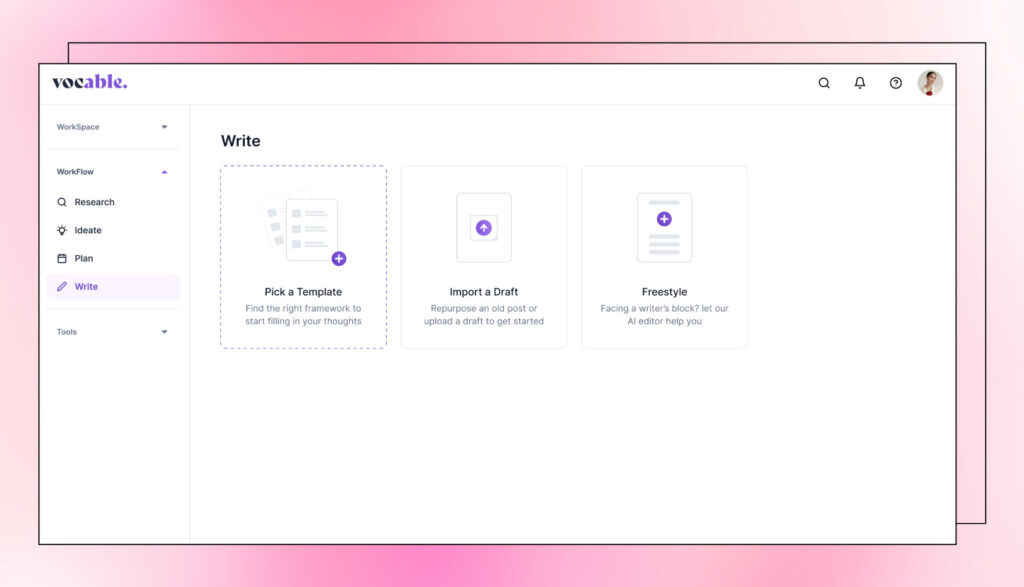
Research Keywords to Boost Your SEO Right From the Start
You write blogs with the goal of reaching a larger audience, and the best tactic to do so is to include keywords (the phrases and expressions your target audience searches on the web about your topic) in your blog article.
When you include keywords in your blog, you tell search engines that this is a valuable and relevant piece of content to show users who are searching for those terms. This can improve your ranking on search engine results pages (SERPs) and ultimately bring more traffic to your website.
Vocable has an AI research tool that searches your topics, breaks down keyword variations, browses the top queries and uses these insights to brainstorm content ideas.
Just insert the topic you want to write about, and Vocable will provide you with a list of keywords and phrases that would be good for your blog post.
Choose Tools from the left-side menu of your Vocable dashboard and click on Research.

Create a Content Brief Before You Start Writing for a Structured Blog Post
A content brief or a content outline is a document that outlines the structure and main points of your future blog post. You define for yourself the key blog ideas or information you want to include, list the key subheadings, and create a roadmap for your writing process by including 2-3 key points about each heading.
When you first work on the content brief, your brain isn’t tasked with the writing aspect, so your focus is on creativity and flow. You are able to think about the big picture and conceptualize your blog ideas before honing in on the details.
Vocable’s Planner tool does this for you. You fill in a quick form including your blog topic, target audience and the goals of your blog (is it sales & conversion, engagement, or anything else?), and the platform proceeds to generate several title options and a content brief based on your topic and audience.
This organized outline, generated by Vocable based on its AI analysis of competitor content on the topic, saves you time and ensures that all important aspects of the blog post are covered.

Fill in the Blanks and Write the Final Article
With a clear brief navigating your writing process, you can now write the actual blog post. Carefully research the web to include accurate information and supporting data in your blog. Create a catchy introduction to hook your readers, and write compelling subheadings that make the article easy to scan.
Unfortunately, there is no easy way to write a great blog post without proper Research. The best blogs are highly authentic and credible, and your readers expect you to be the expert on the topic. Otherwise, why would they bother reading your blog?
Here, you can use AI to accelerate the otherwise time-consuming Research. We recommend you join efforts with Vocable’s AI-powered writing tool that generates the ready-to-use blog draft, which you can later adjust based on your own fact and data-check process.
By clicking on “Create Draft”, you will receive the whole draft of the blog post based on the content brief. Vocable will generate the draft based on insights from similar top-ranking articles as it browses extensive web content and analyzes what works best in seconds.
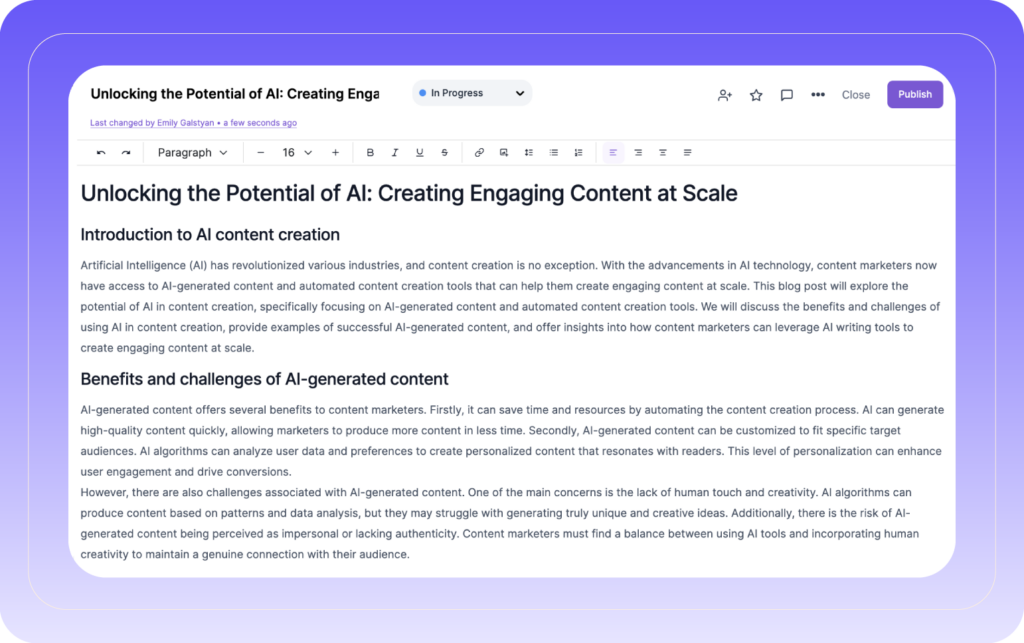
Proofread and Polish Your Blog Article Before Publishing
Finally, with an engaging writing style and powerful arguments, polished content free of grammar and spelling errors triggers positive readers’ emotions.
Polished content includes many nuances that you may miss on the first draft. For example, you need to have proportionally varied sentence lengths, as that creates a more dynamic flow for the readers. Additionally, it’s important to have descriptive language in certain parts of your draft because this helps to create a more vivid picture in readers’ minds and makes the reading experience more enjoyable.
To save you from the tedious proofreading process and guarantee a flawless result, Vocable has an AI-powered Document Health Checker that analyzes your text in real-time while suggesting corrections to your grammar, spelling, punctuation, sentence structure and more.
You get an overall score for your draft, ranging from 0-100, where each score segment is linked to a detailed report with specific recommendations. This helps you understand which areas of your draft need improvement and how you can make those improvements.
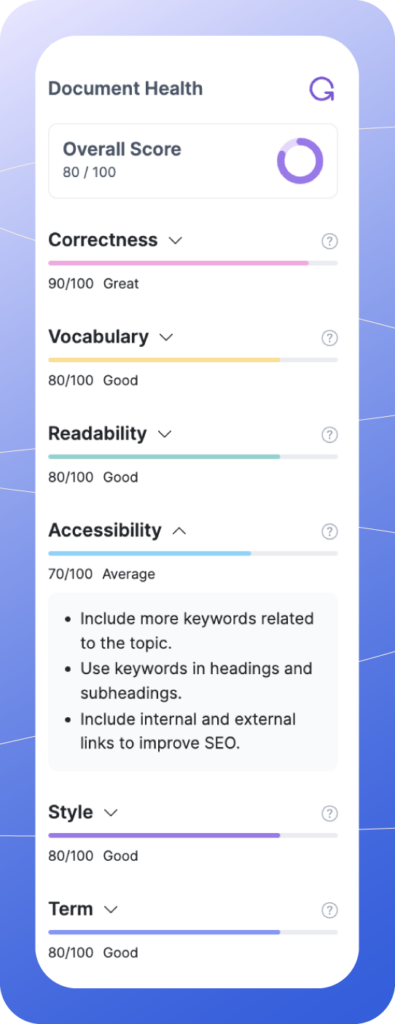
To activate Vocable’s Document Health check, press the refresh button on the upper right corner of your Vocable dashboard. The results will be displayed instantly.

Measuring Blog Success: Key Metrics and Analytics
Without properly tracking how your blog ideas perform after going live, all the hard work you’ve put into creating the blog goes… to waste, at least from a marketing perspective.
No matter how well you did keyword research or how high is the quality of your blog content, you can never say, “I did a good job,” unless your audience reacts positively and you get the desired results.
There are clear SEO blog performance metrics that help you understand how your content works for your target. Most interactions readers take with your content can be measured and tracked, providing you with valuable insights into what worked well in your previous blogs and what should be adjusted in future posts.
Below, we list some of the most-used blog metrics, but remember that each business has its own goals and you should track the metrics that best align with them.
Page Views
Truly good blog ideas should attract more and more readers. Google Analytics is the No.1 tool that can give you an accurate measure of the number of readers your blog has attracted. Since Google dominates the search engine market, tracking its metrics alone is already a good starting point.
Well, Google Analytics allows you to filter the “All Pages” report to view only your blog posts’ results. In most cases, you’ll need to search the URL path of your blog, such as “/blog/ “or a “blog.” in case your blog is located in your website’s subdomain.

The report will show you the results for each blog post separately, where you can check the number of total views (how many visits your content got in total) and unique page views (how many different people visited the blog post). You can also see the average time spent by readers on your blog post, as well as bounce rates that indicate how often users leave your blog right after entering the page.
What to do with these metrics?
If you see a blog post that has a high number of unique page views and an extremely high bounce rate (above 70%), consider optimizing it better with relevant images and formatting to make it more attractive to readers.
Another scenario could be that a blog post has a low number of unique page views but a high average time on the page. This may indicate that readers find your content interesting and engaging, but it’s not reaching enough people. In this case, consider promoting the post through social media or paid ads to increase its reach.
A more profound analysis of your page views can also help you identify the topics that resonate most with your audience and create more content around those subjects to keep attracting readers.
Click-Through Rate
Views are good, of course. But do you really extract the best blog ideas just for people to come and read them?
Well, in some essence, yes. But in the big picture, you want your blog to guide readers through the buyer’s journey and eventually convert them into customers or leads. For this reason, it’s essential to track click-through rates (CTRs) for links within your blogs.
Your blog articles should include CTAs (call-to-actions) that encourage readers to take action, such as downloading a free resource, subscribing to your newsletter or purchasing a product/service. By tracking CTRs for these links, you can understand how well your blog articles navigate your users to take action on your website.
If CTRs are low, consider changing your CTAs to make them more compelling or placing them in a more visible spot within the blog article. You could also try A/B testing different CTAs to see which one performs better.
You can track click-through rates with Google Analytics using Events under the Behavior tab. This report shows you how many clicks on links happened during a specified period. You can also see which specific links your readers clicked on, providing you with valuable insights into which CTAs are most effective.
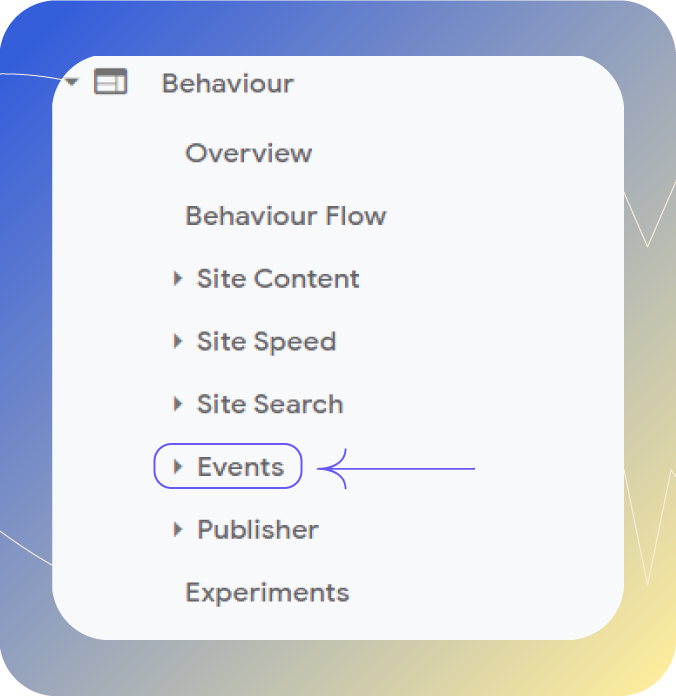
As a beginner blogger with no or low traffic or with yet a lack of experience with analyzing blog metrics, you can use pure link trackers like Bitly. To do this, you will need to shorten your links with the Bit.ly program and place them within your blog posts.
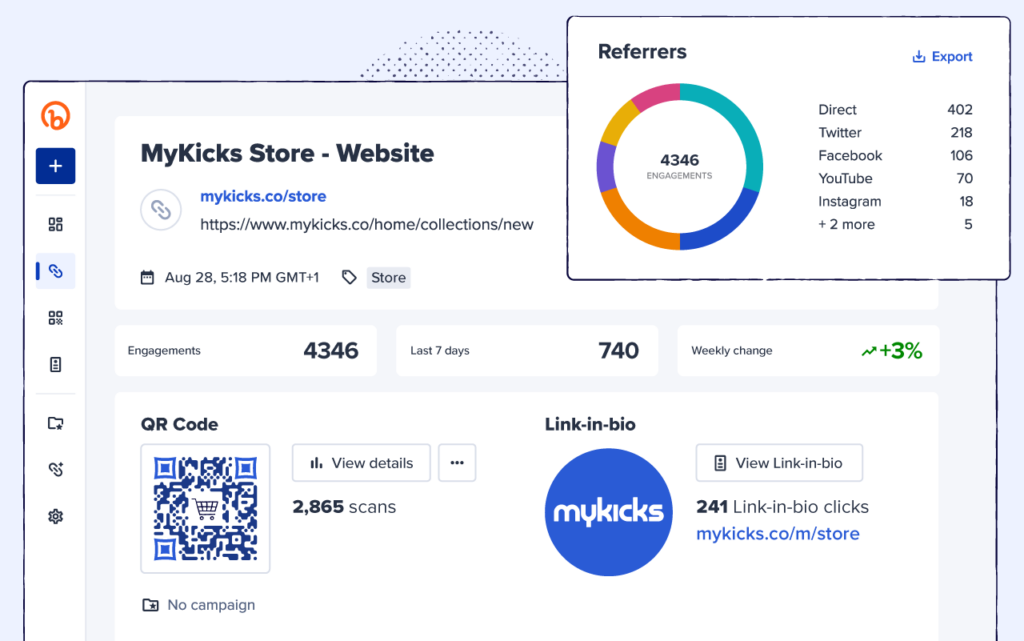
Source: Bitly
Doing so will help you later track basic click-through rates provided by the Bitly tracking system.
No matter how you track clicks on your blogs’ internal links, put effort into having convincing, eye-catching CTAs at the right time, place, and with the right message.
Conversion Rate
Well, many clicks on internal links are quite a good indicator, too, but again… is it your end goal with the blog?
Let’s say a user reads your blog and gets interested in a brilliant CTA inviting them to try your product or service. They click a “Start a Free Trial” button on your CTA, taking them to the product page.
So, the finish line is almost ahead of you, but the user stops there and closes the browser tab without taking any action.
This activity counts as a click but not as a conversion. Conversion metrics measure the percentage of visitors who eventually take an action, such as downloading a resource, submitting a form, or making a purchase.
Tracking conversions is crucial for understanding how effective your blog is at driving leads and sales. You can use Google Analytics to set up and track goals, which are specific actions you want users to take on your website. By setting up goals, you can track each blog post’s conversion rate and identify which are most successful at driving conversions.
For example, your goal in Google Analytics can be submitting a contact form, and the conversion rate will show how many visitors who read a specific blog post filled out that form. This information can help you focus on creating more content around topics that drive conversions and tailor your CTAs to better align with those goals.
By calculating revenues typically associated with each conversion (for example, one subscription brings around $50 for your business), you can also estimate the ROI of your blog posts and see where to invest more.
Social Shares
Though social shares are not a direct linking factor for SEO, they help to boost your website’s overall reputation and indirectly improve your SEO ranking.
Moreover, social shares can also help drive more traffic to your blog. When someone shares your blog post on their social media profiles, it exposes your content to a new audience who may not have otherwise come across it. This can lead to increased views and potential conversions if the shared content resonates with the new audience.
So, when thinking about potential blog ideas, consider choosing the ones that are likely to get shared on social media. These could be timely topics, controversial opinions, or visually appealing content. You know, something that is consumable and share-worthy on social media.
Thus, Google Analytics can help with tracking social shares by using the Social tab under the Acquisition section. This report shows you which social media platforms are driving the most traffic to your blog and which pieces of content are most shared on each platform.

If you want an easier way to track social shares, you can also use tools like ShareThis, AddToAny, and similar. These tools provide easy-to-use social sharing buttons that you can add to your blog posts, making it easier for readers to share your content on their social media profiles. Whenever a website user clicks on one of these buttons, it counts as a social share.
Note! Social share services allow you to track those shares that are done via share buttons. Google Analytics tracks the URL share of your content, so you can get an idea of how many people have shared your blog post via copying and pasting the link or how much traffic a specific URL took from social media.
Key Takeaways
Great blog ideas have a heavy load to be a universal link magnet. They should grab readers’ attention, provide value and drive action – whether it’s sharing or converting.
It’s never about pure SEO optimization, nor should you focus only on conversions. It’s about finding the balance between user intent and business goals while creating high-quality, engaging content. If one of those aspects is left behind, the others will suffer.
So, take your best weapon – analytics tools that will help you learn the interests of your target audience inside out. Use that knowledge to create and distribute content, interact with your readers, and drive action.
In this continuous cycle of writing, analyzing, and adjusting your content strategy, you are not alone. Vocable’s all-in-one content marketing platform offers a variety of tools to help with your blogging journey, from keyword research and topic ideation to content optimization and tracking.
It’s the magic booster that will help you achieve the ultimate goal of every blogger – create content that drives results.





